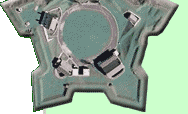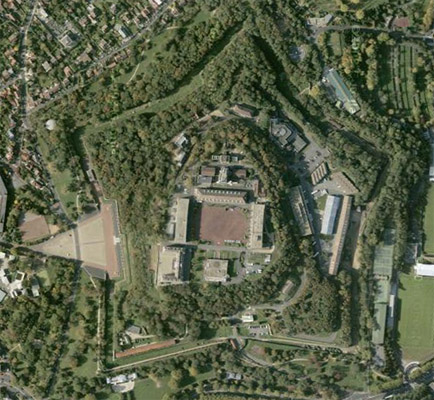
 |
 |
Fort du Mont-Valerien Paris, France |
 |
 |
 |
 |
 |
||
 |
The largest and prettiest of the sixteen star forts exhaustively detailed on our Fortifications of Paris page, Fort du Mont-Valerien was built in 1841. During this period the French were frantically preparing for an imagined invasion having to do with the Treaty of London in 1839: All of Europe's powers had signed the treaty guaranteeing the sovereignity of Belgium from the United Kingdom of the Netherlands...except for France, which had not been invited to the treaty negotiations. French Prime Minister Adolphe Thiers (1797-1877) convinced King Louis-Philippe (1773-1850) that the dithering that had been going on for the past 25 years regarding how best to defend Paris from great marauding German-, Spanish-, Italian-, Russian- and/or English-speaking hordes was now OVER! The Thiers Wall and sixteen new star forts were built over the next five years in the interest of defending the City of Light. Napoleon III (1808-1873) declared war on Prussia on July 13 1871, and by September of that year the Prussian Army, having ground the French Army into hamburger and captured Napoleon III at Sedan, was knocking on Paris' gates. Fort du Mont-Valerien was one of the few of Paris' sixteen forts to hold out through the Prussians' four-month siege, withstanding artillery bombardment from the French-built forts that had already fallen. Prussia's Iron Chancellor Otto von Bismarck (1815-1898) accepted France's surrender on January 17 1871. The armistice allowed Prussian forces to occupy Fort du Mont-Valerien and the rest of the city's fortifications in exchange for food for Paris' starving populace. The Prussians occupied Paris until September of 1871. Fort du Mont-Valerien was used primarily as a prison following the Franco-Prussian War. The Dreyfus Affair was a weird event that divided France in the 1890's and early 1900's. Alfred Dreyfus (1859-1935), a French artillery officer, was convicted in 1894 of giving French military secrets to the Germans, and sent to solitary confinement at Devil's Island in French Guiana. It was later revealed that another officer was the guilty party in this case, and that Dreyfus was completely innocent...but the French military authorities covered up mounting evidence that exonerated Dreyfus, at least partially because he was a jew. Hubert-Joseph Henry (1846-1898), an army counterintelligence officer, forged documents in 1896 that proved Dreyfus was the culpruit. Eventually Henry's forgeries were discovered, Dreyfus was freed, French society divided into Dreyfusards and anti-Dreyfusards, and several high-ranking French officers resigned in disgrace. Henry was incarcerated at Fort du Mont-Valerien, and on August 31 1898 he cut his own throat with a razor that had conveniently been left in his possession. From 1940 to 1944, the nazis used Fort du Mont-Valerien as a prison and execution clearing house: What looks to have been thousands of French resistors and/or people the Germans didn't like were executed there. French Military leader and later President Charles de Gaulle (1890-1970) consecrated Fort du Mont-Valerien on June 18 1945, and it now serves as a memorial to the French Resistance. The fort also has a military cemetery in which 1541 American soldiers who died in the First World War (1914-1918) are buried. |
 |
 |
||
|
|
|||||||
Info Source 1 Info Source 2
Info Source 3
Info Source 4 Info Source 5 Info Source 6 Info Source 7 Info Source 8 Info Source 9 Info Source 10 Thanks to Google Maps for the image! ©2010 starforts.com |
 |